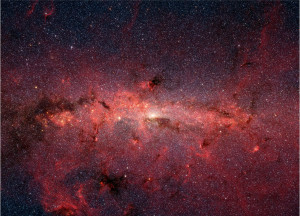 Have you ever looked up at the night sky and wondered what those bright little specks are and what they are called? Well, if you are looking for an answer, the answers can be found within the Astronomy courses here at Sinclair. The Astronomy courses are contained within the Physics Department in Building 4, and I sat down for a short interview with one of the primary instructors of the Astronomy program, Professor Lori Cutright, who has been teaching Astronomy at Sinclair since the fall of 1992. Mrs. Cutright primarily teaches AST 1111: The Solar System and its required laboratory AST 1117: Lab for the Solar System but also teaches the other Astronomy course AST 1112: Stars, Galaxies and the Universe and its required laboratory AST 1118: Lab for the Stars, Galaxies and the Universe every so often as well as, up until this past Summer Semester, PHY 2245: Concepts in Physics.
Have you ever looked up at the night sky and wondered what those bright little specks are and what they are called? Well, if you are looking for an answer, the answers can be found within the Astronomy courses here at Sinclair. The Astronomy courses are contained within the Physics Department in Building 4, and I sat down for a short interview with one of the primary instructors of the Astronomy program, Professor Lori Cutright, who has been teaching Astronomy at Sinclair since the fall of 1992. Mrs. Cutright primarily teaches AST 1111: The Solar System and its required laboratory AST 1117: Lab for the Solar System but also teaches the other Astronomy course AST 1112: Stars, Galaxies and the Universe and its required laboratory AST 1118: Lab for the Stars, Galaxies and the Universe every so often as well as, up until this past Summer Semester, PHY 2245: Concepts in Physics.
Mrs. Cutright said that the one thing that makes Astronomy stand out from every other science was the sense of wonder about the stars. “People have [been] looking at the stars wondering about them since people were people,” Mrs. Cutright explained, “You go outside and wonder, ‘Which star is that?’, ‘Why is that?’, ‘What makes them shine?’ Or ‘Why do they move?’.” Mrs. Cutright pointed out that the fact that people going so far back as the ancient Egyptians and Greeks, who themselves shared the very same wonder, have used the stars for time and calendars but maintained that it was the general sense of wonder, looking up at the night sky that drew people of all sorts in and made them ask questions about what was out there.
Mrs. Cutright used an interesting analogy in describing the science of Astronomy and the stars themselves. “They’re old friends,” she says, “Those stars are so far away, there is absolutely nothing people could do to affect them. We cannot hurt the stars. They will always be there, they are always there. So if I’m feeling bad about something, I can go outside and I can look up and those stars are there. Even if I can’t see them, if it’s cloudy or pouring rain, those stars are there. They are always there. If I know their names, they’re old friends.”
Mrs. Cutright also went into detail about the various technological advances that both went into astronomical studies but also all of the products that were spin-offs of the space program; the idea of miniaturization (making large objects smaller yet work the same) was a direct effect of the Apollo program, because of the way the Apollo astronauts had to cut weight to make way for more fuel to propel them into space.
Plastics were developed, as were light-weight thermal blankets. Another by-product of such programs was the effect of weightlessness being similar to that of aging. So, not only has astronomy been helpful to our imaginations, but it has helped humanity in many more ways than once thought possible.
Here at Sinclair, there only two astronomy courses offered and much like other science courses, the astronomy courses go together, one followed by the other. The two courses offered are AST 1111: The Solar System (which is the one this reporter is presently taking) and AST 1112: Stars, Galaxies and the Universe. Students must complete AST 1111 before attempting AST 1112, as they run together.
There are also concurrent laboratory classes students must take that coincide with the lecture classes. Those labs are labeled AST 1117: Lab for The Solar System and AST 1118: Lab for Stars, Galaxies and the Universe. Both courses are three credit hours and their lab courses are one credit hour, so they take up quite a bit of space on a semester schedule. Make sure you have plenty of time to devote to these classes. However, they are loaded with a great deal of interesting material that will keep you thinking. AST 1111 focuses strictly on our local solar system and all of the objects contained within it, while AST 1112 focuses on essentially the rest of the universe.
Christopher Witt
Reporter

